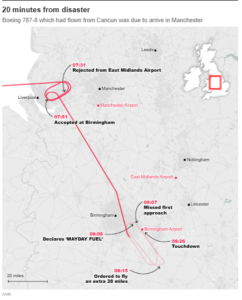20 minutes from disaster: Jet With 300 Passengers Almost Runs Out of Fuel Over Birmingham
A plane carrying nearly 300 holiday passengers came dangerously close to disaster after almost running out of fuel in mid-air.
The Boeing 787-8 was flying from Cancun, Mexico, to Manchester Airport during Storm Pia’s 100mph winds in December 2023.
As the plane prepared to land, the pilot was told there were seven other aircraft waiting for conditions to improve before landing safely.

Air traffic controllers couldn’t give him a landing time, so the 62-year-old pilot decided to divert to East Midlands Airport.
But East Midlands said they couldn’t handle a plane of that size, so he was redirected to Birmingham instead.
Strong winds forced the pilot to cancel the first landing attempt. As he circled to try again, he declared a ‘mayday’ because the plane was running dangerously low on fuel.
At that point, the jet—already sent 28 miles off course despite the fuel emergency—had no option to fly to another airport.
A report released today by the Air Accidents Investigation Branch (AAIB) said the plane, carrying 291 passengers and ten crew, landed with just 1,250kg of fuel.
Since the plane was burning 60.5kg of fuel per minute, it would have run out in 20 minutes—barely enough time for another landing attempt if needed.
Safety rules require a plane to land with at least 1,911kg of fuel.
The TUI flight, number TOM173, left Cancun at 5:50 pm local time on December 20, 2023, for an overnight journey to Manchester.
The crew knew about strong winds in England but expected them to calm down by 6:00 am, while their plane was due to land at 7:35 am.
Still, they decided to add 984kg of extra fuel, which gave them about 15 more minutes of flying time.
At 7:18 am, they contacted Manchester Air Traffic Control and were told to circle above the airport, waiting behind seven other planes. At that time, they had 5,500kg of fuel left.
The controller said they couldn’t predict when the plane could land because of the delays. The pilot circled the airport several times before deciding to divert.
Wind speeds were around 32mph, with gusts reaching 47mph.
At 7:28 am, the pilot contacted East Midlands Airport about diverting there, but three minutes later, they were told, “We cannot accept your size aircraft.”
Storm Pia caused major problems for flights on December 21, 2023, affecting many airports across the UK.

At 7:41 am—six minutes after the scheduled landing time—the plane was finally allowed to divert to Birmingham, but it only had 4,100kg of fuel left, which was enough for about an hour.
When the plane contacted Birmingham’s radar, the pilot warned, “We are gonna be on minimum fuel.”
At 8:05 am, the plane was cleared to land and began descending but had to cancel the landing at 240 feet due to strong winds, which were gusting at 43mph.
While climbing back up to 4,000 feet at 8:08 am, the crew sent a distress call: “TOM173 MAYDAY MAYDAY MAYDAY, TOM173 MAYDAY FUEL.”
Air traffic controllers then sent the plane 25 miles south of the airport before putting them behind another aircraft—doubling the diversion distance to 53 miles and using up 1,450kg of fuel.
This extra 28-mile route reduced the plane’s fuel reserve by another 400kg.
The plane finally landed in Birmingham at 8:26 am with just 1,250kg of fuel left, which would have lasted only 20 more minutes.
The flight was supposed to last eight hours and 45 minutes but ended up lasting nine hours and 36 minutes.
The AAIB report found that Birmingham’s air traffic controller should have given the flight priority earlier.
The investigation found that the controller was dealing with a complicated and busy situation, which caused them to miss the chance to prioritize TOM173 over a Wizz Air plane.
As a result, TOM173 had to fly a longer route even though it had declared a fuel emergency.
The AAIB report stated: “Airlines try to carry only the necessary fuel for a flight because carrying extra fuel burns more fuel.
“However, the crew saw a risk of strong winds and possible delays at Manchester Airport.
“They incorrectly believed the winds would calm down after 6:00 am, so the pilot requested some extra fuel—about 15 more minutes’ worth.
“But given the weight of the plane, they could have added a lot more fuel.
“The reduced fuel reserves limited the options available for a safe landing if they had to attempt another landing due to wind issues.
“This serious incident happened because of strong winds making landing difficult when the plane arrived in the UK.
“New safety measures have been introduced to improve communication about airport capacity for diversions and how to prioritize planes that declare emergencies.”
